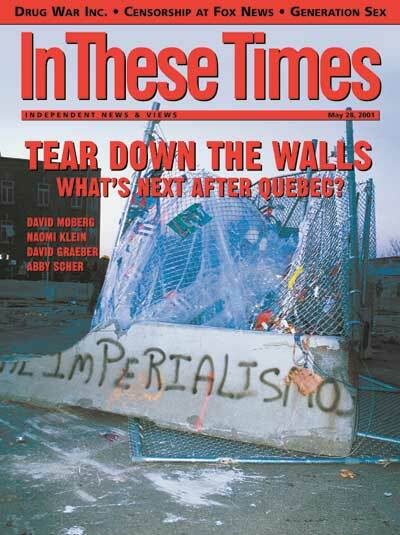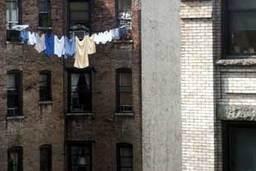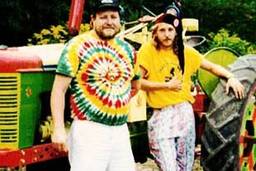In the beginning was the Ramones. You can still hear impassioned barroom arguments about where punk-rock started – New York? London? the Stooges? any of a thousand obscure ’60s garage bands? – but the Ramones indisputably codified the sound of the fury, a blitzkrieg of eighth-note guitar downstrokes and bass hammer-ons.
Buried under the noise – and all the hype about punk being a lot of negative, destructive, no-talent junk – the Ramones were brilliant songwriters. Their songs had verses, choruses, bridges and hooks – beautifully crafted, energetic and innocent like the Brill Building pop tunes they exploded. “Rockaway Beach” has got to be the best rock ‘n’ roll summer song ever, from its “ONE-TWO-THREE-FOUR!” intro to its Beatles/Beach Boys bridge, a whole universe flashing by in two-and-a-half minutes.
For punk rockers, the death of lead singer Joey Ramone of lymphoma on April 15 – he was 49 – was like John Lennon’s: a beloved, seminal figure gone too soon. Not only did the Ramones give punk a definition, condensing a signature sound out of a nebulous assortment of New York bands, but they far outlasted any of their ’70s contemporaries, surviving into the mid-’90s. Their radical simplicity – their 1976 first album was recorded for $6,000 and featured not one guitar solo – was a revelation to a generation of neurotic outsiders, creating an alternate universe where “Sheena Is a Punk Rocker” ruled the charts.
And they were fun, combining wonderfully warped humor with a melodic blast intense enough to explode white mice. I remember coming home in the subway from their Central Park show in 1980, one of us shouting “LOBOTOMY!” and someone on the opposite platform yelling back, “LOBOTOMY!” That kind of rock ‘n’ roll community’s long gone now, or maybe I’ve aged out of it, or maybe it’s passed on to rave and hip-hop; punk was a failed revolution, unable to dent the music business and the star system that turns everything into product.
It’s hard to re-imagine just how hated punk was in the ’70s, now that green hair is a common affectation and “Blitzkrieg Bop” a beer commercial. Even the erstwhile rebels of the post-hippie rock scene denounced punk in prudish-parent terminology. This pretty much denied the Ramones commercial success – neither 1977’s Rocket to Russia, widely considered their best album, 1978’s Road to Ruin, despite the ubiquity of “I Wanna Be Sedated,” nor their 1980 collaboration with Phil Spector cracked the Top 40.
(In his autobiography, Lobotomy, bassist Dee Dee Ramone recalls Spector as a drunken control freak, holding the band hostage at gunpoint.) But they persevered, touring hard and putting out a consistent string of albums. The band’s interpersonal dynamics got severely strained, causing Dee Dee to leave, but by the ’90s they were playing football stadiums in Argentina and Brazil.
Unlike British punk, the original New York punk was not overtly rebellious; in fact, it was often militantly apolitical, a reaction to post-hippie rock’s pretension and sanctimony. (Guitarist Johnny Ramone was once quoted as saying “punks should have no politics or be right-wing.”) But between the influence of the younger “hardcore” punk bands of the Reagan era and Dee Dee turning to face his personal demons and political nightmares, the Ramones changed in the ’80s, starting with 1984’s Too Tough to Die. Joey’s contribution was “Bonzo Goes to Bitburg,” a bell-seasoned bemoaning of Ronald Reagan’s 1985 visit to an SS cemetery.
It’s easy to overestimate the political significance of punk. One can understand the impulse to use fashion to signify rebellion, to be a walking billboard blaring I defy your society of pap and greed, your force-propped authority–but dressing up funny never made a revolution, nor did buying records and going to shows. That lesson was driven home hard in the early ’90s, when the success of Nirvana translated into global entertainment conglomerates marketing rebellion-lite as “alternative.” Still, punk, especially the do-it-yourself ethos of the ’80s hardcore scene, spawned legions of young activists. If it weren’t for punk rock, the black flag of anarchy would be a minor historical footnote in between Emma Goldman and Leon Czolgosz.
Whatever. Punk rock produced some of the livest, most vital music ever. And Joey Ramone was its goofy, impassioned godfather, a misfit from a Queens high-rise who embodied the spirit of New York City rock ‘n’ roll. It may have been a minority obsession, but it was a fierce one. When I heard the news on April 15, I put on the radio – Joey deserved a 24-hour all-Ramones marathon – but the classic-rock station was playing Creedence, R.E.M. and Elton John, and the modern-rock station was playing some Pearl Jam or Alice in Chains knockoff. I turned it off and put on “We Want the Airwaves,” “I Wanna Be Your Boyfriend” and “The KKK Took My Baby Away.”








